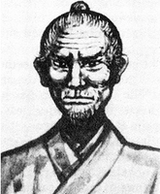Bushi Sokon Matsumura

Bushi Sokon Matsumura 1809 – 1901
The Boss Man

Matsumura Sōkon was born in Yamagawa Village, Shuri, Okinawa.
Matsumura began the study of karate under the guidance of “Karate Sakugawa”. Sakukawa was an old man at the time actually 78 years of age and reluctant to teach the young Matsumura, who was regarded as something of a troublemaker. However, Sakukawa had promised, Matsumura Sōkon’s father, that he would teach the boy, and thus he did. Matsumura spent five years studying under Sakukawa. As a young man, Matsumura had already garnered a reputation as somewhat of a talented martial artist.
 Matsumura is
credited with passing on the Shōrin-ryū karate kata’s known as naihanchi I & II, passai, seisan, chintō, gojūshiho, kusanku (the embodiment of Kusanku's
teaching as passed on to Karate Sakugawa) and the hakutsuru (white crane) kata as well.
Matsumura is
credited with passing on the Shōrin-ryū karate kata’s known as naihanchi I & II, passai, seisan, chintō, gojūshiho, kusanku (the embodiment of Kusanku's
teaching as passed on to Karate Sakugawa) and the hakutsuru (white crane) kata as well.
Matsumura was given the title "bushi" meaning "warrior" by the Okinawan King Sho Ko in recognition of his abilities and accomplishments in the martial arts. Matsumura was the chief martial arts instructor and bodyguard for the Okinawan King Sho Ko.
Gichin Funakoshi said he was a sensei with a terrifying presence, Matsumura was never defeated in a duel, though he fought many. Tall, thin, and possessing a pair of unsettling eyes, Matsumura was described by his student Ankō Itosu as blindingly fast and deceptively strong. His martial arts endeavors have been the progenitor of many contemporary karate styles: Shōrin-ryū, Shotokan, and Shitō-ryū, for example. Ultimately, all modern styles of karate that evolved from the Shuri-te lineage can be traced back to the teachings of Bushi Matsumura. Of note, his grandson was the modern Tōde master, Tsuyoshi Chitose, who assisted Gichin Funakoshi in the early introduction and teaching of karate in Japan and who founded the Chitō-ryūstyle.
